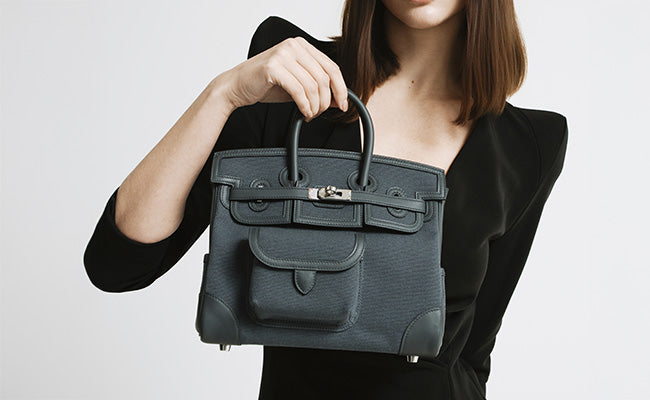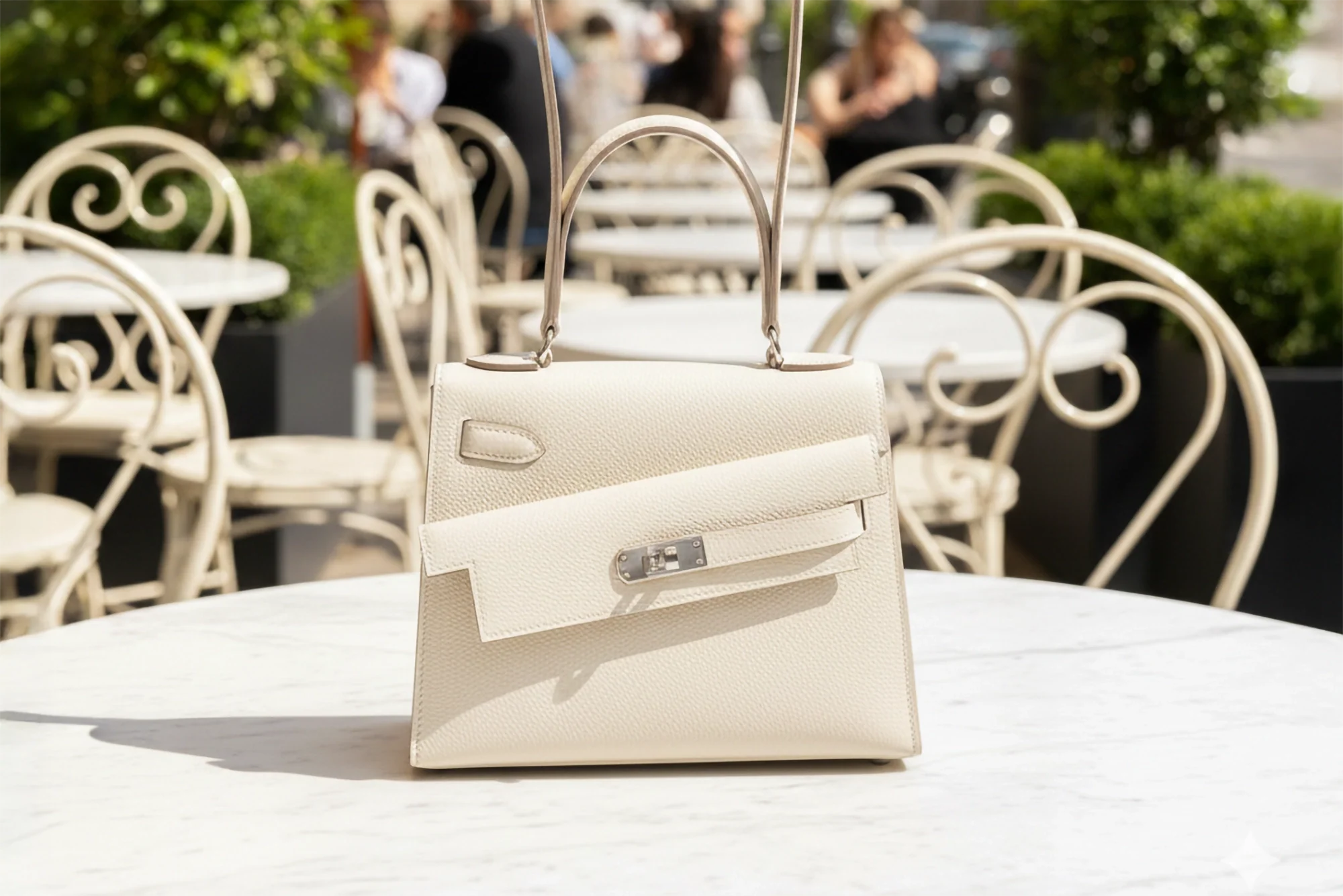
Ostrich at Hermès: Pores, Color Play, and Care Myths
Check out our Hermès collection and Birkin bags!
When collectors talk about Hermès exotic leathers, ostrich often takes a back seat to the glitz of crocodile and alligator. But this quirky material, with its unmistakable quill follicles and wild dye absorption, actually produces some of the most coveted pieces out there.
You hear rumors about ostrich being “fussy” or see those old bags looking weirdly untouched by time.
Ostrich leather’s pore structure and ability to hold color make it one of Hermès’ most technically impressive exotics. Still, myths about its care and fragility scare off plenty of would-be fans.
The truth? It’s a lot more interesting and less intimidating than the stories let on. From the dense follicles of the crown leather to shades you’ll only find on ostrich, there’s a lot going on that’s impossible to copy with other skins.
If you’re eyeing your first ostrich Birkin or just wondering why an ostrich Kelly Elan Folie can cost a small fortune, it pays to know what’s hype and what’s real.
Let’s dig into what makes ostrich tick, how its color evolves, and which care tips actually matter.
Key Takeaways
- Ostrich leather’s quill follicles and wild dye absorption give it a look and feel you don’t get with other Hermès exotics.
- Myths about ostrich being fragile or “high-maintenance” keep a lot of collectors from using their bags.
- Picking the right color and understanding patina lets you get the most out of your ostrich bag, both for fun and as an investment.
Signature Look: Ostrich Leather and Its Iconic Pores
Ostrich leather’s bumpy quill follicles create a texture you can spot from across the room. Hermès doesn’t just use these “pores”, they highlight them, picking the best spots on the hide to show off.
Spotting Ostrich: The Story Behind Those Dots
Those little bumps on ostrich leather? They’re quill follicles, the places where feathers once grew. Every bump marks where a feather was plucked during processing.
The crown section (back and neck) gives the most prized pattern. That’s where the follicles cluster tightly, making that classic “goosebump” look everyone recognizes on a Hermès.
What’s cool is how random these follicles appear. Crocodile scales run in rows, but ostrich bumps flow in unpredictable ways, so every hide is different.
Follicle size and spacing matter a lot. The best ostrich leather has evenly spaced, raised bumps that make the texture pop. Less desirable sections look flatter or patchy.
How Hermès Highlights Ostrich Texture in Bag Design
Hermès artisans don’t just slap ostrich leather on a bag, they carefully position the crown section’s best follicles right where you’ll see them most. The front panel usually gets the showstopper piece, while other areas use well-matched sections.
Cutting patterns from ostrich is almost an art itself. Hermès makes sure the most dramatic texture lands front and center, think the face of a Birkin or Kelly.
Color choices matter, too. Bright shades like Bougainvillea and Blue Jean make the follicles catch the light, so the texture looks even richer.
Hardware can get tricky. Hermès flattens the leather under clasps and plates so the metal sits flush, but they’re careful not to ruin that signature ostrich look.
Colour Play: The Hermès Ostrich Palette and Patina
Ostrich leather soaks up dye in a way that’s totally different from other exotics. Hermès can pull off colors on ostrich that just don’t work on crocodile or lizard. That deep color also means the way ostrich ages is pretty unique.
How Ostrich Takes Colour: Dyes, Finishes, and Standouts
Ostrich’s follicles act like tiny dye traps, so the color gets really saturated and almost glows from inside the leather.
Certain colors? You’ll only see them on ostrich. Violine and Tangerine are classic examples, never offered on other exotics. Violine’s deep purple really shows off ostrich’s ability to hold a bold, rich tone.
Because dye sinks in, the color stays consistent all the way through the hide. Hold an ostrich Birkin under different lights and the shade barely changes.
Exclusive Ostrich Colours at Hermès:
- Violine (deep purple)
- Tangerine (bright orange)
- Rose Shocking (vivid pink)
- Bleu Electrique (electric blue)
The densest follicles (from the crown) soak up the most dye, which is why crown-heavy bags fetch such high prices.
Fading, Darkening, and the Unique Patina of Ostrich
People worry about ostrich fading, but if you take care of it, fading’s not the big issue. What actually happens? The leather darkens, especially where your hands touch it most.
Handles show this the fastest. After a few months, oils from your skin deepen the color, giving the bag personality. That’s not a flaw, it’s character.
Common Patina Patterns:
- Handle darkening (most obvious)
- Corners get a little deeper in color
- Spots where hardware rubs may change a bit
Light shades like Rose Sakura and Craie show patina quickly, especially on handles, and honestly, some collectors love that honeyed look more than the original.
Sunlight is the real enemy. UV rays can bleach ostrich, especially pale colors, so stash your bag in its dust cover when you’re not showing it off.
The patina settles in after about a year of use and then pretty much stays put.
Most Coveted Ostrich Colours in Hermès Bags
Black is the classic for a reason. It hides patina, shows off the texture, and black ostrich Birkins always do well in the resale market.
Gold strikes a nice balance, warm, rich, and forgiving of little marks or wear.
Dark shades are always popular:
- Bordeaux (wine red)
- Vert Foncé (forest green)
- Bleu Nuit (midnight blue)
Brights like Rose Shocking and Tangerine are pricey because you can only get them in ostrich. They really show off how well ostrich takes dye.
Collectors seem to be leaning more toward shades that age gracefully. Marron and Graphite develop a patina that gives the bag even more depth.
If you want to talk rare, discontinued colors on popular models are where it’s at. A 25cm ostrich Birkin in Violine with palladium hardware recently topped $80,000 at auction, people are chasing these.
Debunked: Ostrich Leather Care Myths
There’s a lot of bad advice out there about ostrich care. Some myths can actually harm your Hermès, and not all leather products are safe for exotics. Sunlight? Way more damaging than most realize.
True Durability: Fact vs. Fiction
You’ll hear folks say ostrich is “indestructible” or “maintenance-free.” It’s tough, sure, but not invincible.
The Reality:
- Ostrich has natural oils that help prevent cracking
- It’s more flexible than most other exotics
- But it still fades if you leave it in the sun
- The follicles don’t make it bulletproof
Some say ostrich wrinkles easily, but that’s not really true. If you look after it, ostrich keeps its shape well.
Don’t expect miracles, though. An ostrich Birkin will outlast plenty of bags, but treating it like it’s indestructible is a fast track to disappointment.
So, what’s reasonable?
- Expect it to last, not live forever
- Natural oils help, but you still need to care for it
- Full quill and smooth quill have different strengths
Water Resistance, Scratches, and Everyday Care
The idea that ostrich is “waterproof” is just wrong. It resists moisture better than some, thanks to those oils, but it’s not immune.
If you spill:
- Blot right away with a dry, soft cloth
- Don’t rub or spread the moisture
- Use a damp cloth only if you must, and just for stains
- Let it dry evenly so you don’t get water marks
The follicle pattern does help hide small scratches, but deep ones will still show. Light marks usually blend in over time.
For fresh oil stains, sprinkling talcum powder and brushing it off after an hour often works.
Daily Care Don’ts:
- Skip regular leather cleaners, they can mess up ostrich
- Don’t use standard conditioners
- Always test anything new on a hidden spot first
How to Prevent Common Ostrich Leather Mistakes
Biggest mistake? Using regular leather care products. They can discolor or clog the follicles.
What to do:
- Use only cleaners made for exotics
- Always patch test
- Skip soaps and harsh chemicals
Sunlight is the most avoidable problem. Lots of ostrich Hermès bags have faded spots from being left out or under store lights.
Best storage tips:
- Keep your bag in a cool, dry spot
- Use its dust bag or a clean box
- Avoid direct sun and heat
- Let it breathe, don’t seal it up tight
Over-conditioning is another trap. Too much product can darken ostrich or fill in the follicles.
Conditioning basics:
- Clean every couple of weeks with the right stuff
- Only condition if the leather feels dry
- Go light, thin, even layers
- Buff off any extra after 15 minutes
- Let it dry before you put it away
If in doubt, get it professionally cleaned every few years. That’s usually better than trying to fix problems yourself.
Ostrich in the World of Hermès Exotic Leathers
Within Hermès’ exotic lineup, ostrich stands out for its bumpy texture and surprising toughness. Crocodile and alligator might be pricier, but ostrich has its own loyal following. Sometimes, Hermès even mixes exotics in a single bag for a real showstopper.
Ostrich vs. Crocodile, Alligator, and Lizard: Key Differences
Stacking up the exotics, ostrich holds a special spot. Unlike the stiff, rectangular scales of Crocodylus niloticus (Nile croc) or Alligator mississippiensis, ostrich is flexible and a bit more forgiving.
Price-wise, croc is king, then alligator, then ostrich and lizard (which are still expensive, just not as wild).
Texture?
- Ostrich: Bumpy follicles, smooth in between
- Crocodile/Alligator: Blocky, geometric scales
- Lizard: Tiny, even scales, almost like dots
Ostrich laughs off scratches better than croc, thanks to the raised bumps. Crocodile, though, needs careful handling to keep those scales pristine.
Varanus salvator (water monitor lizard) is the most delicate, gorgeous, but you have to baby it compared to ostrich.
When it comes to color, ostrich wins for saturation. Croc leans toward muted shades, while lizard can go bright but is much more fragile.
When Hermès Marries Exotic Leathers in One Bag
Sometimes Hermès gets creative, mixing exotics in a single piece. The results? Pretty spectacular.
You’ll spot Kelly bags with ostrich bodies and crocodile handles or straps. The clash of textures, bumpy ostrich against geometric croc, really catches the eye.
Birkin variants sometimes use ostrich for the main panels with lizard accents. These combos take serious skill, since each skin behaves differently.
The Constance sometimes shows off ostrich with an alligator H-closure, making the hardware a focal point.
These mashups are rare, usually special orders or for VIPs. Only Hermès’ top artisans tackle them, since mixing exotics is tricky business.
Prices for these combos? Always higher than for single-exotic bags. They’re collector bait, no question.
Design and Hardware Details That Set Ostrich Bags Apart
Ostrich leather calls for special design choices. Hermès uses hardware, stitching, and finishing touches that work with the leather’s quirks, not against them. The result is a look and feel you just don’t get with any other exotic.
Hardware Choices: Gold, Palladium, and Beyond
Gold hardware stands as the classic with ostrich leather, especially on those rich tones like Honey or Terre Cuite. The warmth of gold just seems to fit right in with the earthy hues ostrich leather shows off so well.
Palladium hardware gives a modern vibe, pairing nicely with the cooler ostrich shades. You’ll spot this combo a lot on Gris Tourterelle or other neutrals, it’s a sophisticated contrast that feels fresh.
Hardware isn’t just about looks, though. Ostrich leather’s lightness means you’ve got to think about hardware size and weight to keep the bag balanced.
Hermès sometimes releases ostrich bags with limited-edition hardware finishes. These special runs get snapped up by collectors and fetch wild prices.
Tonal Stitching and Functional Finishes
Tonal stitching on ostrich bags takes some serious skill. The thread needs to blend with the leather’s quirky texture, not fight with those natural quill follicles.
Hermès mostly sticks to subtle contrast stitching for ostrich, nothing too bold or distracting.
Edges on ostrich bags get extra attention. Ostrich texture means you can’t treat the edges like you would smooth calf leather.
Glazing methods shift depending on the quirks of each ostrich hide. Some spots need extra finishing to shield those delicate follicles from everyday wear.
Clochette, Lining, and the Hermès Touch
The clochette on ostrich Birkins and Kellys usually matches the exterior leather, keeping things cohesive and letting the ostrich texture pop, even in tiny details.
Inside, Hermès often uses chèvre lining, which holds up well and feels just as luxe as you’d hope.
They really think about hardware placement, too. Ostrich’s unique texture shapes how clasps and locks sit on the bag.
Stress points on ostrich bags get reinforced, but Hermès does it so the bag stays beautiful and lasts without looking overbuilt.
Spotlight on Icons: Ostrich Birkin and Other Favourites
The ostrich Birkin is the icon everyone wants, but honestly, Kelly and Constance bags in ostrich are just as tempting, each with their own vibe.
Ostrich Birkin: Why It's a Collector's Darling
Ostrich Birkins keep breaking records at auction, and honestly, it’s not just hype. The 30cm size rules the resale space, though those in the know chase the elusive 25cm.
So what’s the magic? Ostrich soaks up dye in a way that other leathers just can’t. You get colours that are impossible to replicate elsewhere.
Picture Graphite, that deep, chic grey that works with everything. Or Raisin, a rare burgundy you’ll hardly find in croc or Togo. Gold and Sable bring out honeyed tones that look incredible with the natural quill pattern.
Those follicles add texture without being loud. Ostrich ages in its own way, handles pick up patina from your hands, but it adds character, not damage.
Investment-wise, ostrich is strong. Hermès keeps production tight, and boutiques don’t always get them. That scarcity, plus the leather’s unique look, keeps demand high.
Other Must-Have Ostrich Creations by Hermès
Beyond Birkins, ostrich Kellys, both Sellier and Retournée, are seriously covetable. The 25cm Kelly in ostrich? It’s got structure for work and a playful side for weekends.
Constance bags in ostrich are collector catnip. Their smaller size lets the quill pattern shine without overwhelming the bag. These sometimes gain value even faster than the bigger bags.
Mini Kellys and Kelly Pochettes are the holy grail for ostrich collectors. The material just works at this scale, packing a lot of luxury into a tiny package.
Every now and then, you’ll see wild pieces like the Kelly Elan Folie, where Hermès layers real ostrich feathers over leather. These are rare, almost wearable art, and made for the collector who wants something nobody else has.
Frequently Asked Questions
People ask about ostrich leather all the time, what’s real, what’s myth, and how to keep it looking sharp. Here’s what we’ve learned, plus a few trade secrets to help you spot quality and care for your ostrich treasures.
What's the real deal with ostrich leather pores, can you actually tell the quality from the number or pattern?
Those pores (the bumpy bits where feathers used to be) tell a story, but not the one you might expect. You can’t just count pores like you’re grading produce.
What actually matters? Consistency and definition. The best ostrich leather comes from the crown section, with well-spaced, raised follicles that feel firm when you touch them.
Lesser ostrich leather might have flat or weirdly spaced pores, often from sloppy quill removal. Good pores should feel sturdy, not like they’ll cave in if you press.
Hermès always uses the crown for main panels, so you get the best pore patterns there. Handles and side panels have smaller pores, and that’s intentional.
Is it true that certain colours of ostrich leather fare better over time, eh?
Definitely, and it’s not just about hiding a bit of dirt. Darker shades, noir, etain, gold, develop richer patinas as they age, which really brings out the leather’s beauty.
Lighter colours can show wear more, but that doesn’t mean they’re fragile. If you pick craie or blanc, just know you’ll need to baby them a bit more.
Bright shades like rose pourpre or bleu saphir might fade a touch in sunlight, but with the right care, they stay vibrant for years. We’ve seen decades-old ostrich bags in wild colours that still look fantastic because their owners took care.
Hermès uses vegetable tanning, which helps every colour age gracefully. Other brands use chrome tanning, but that doesn’t give you the same patina.
How do you keep an ostrich leather bag looking as posh as the day you snagged it from Hermès?
Gentle is the name of the game. Use a barely damp cloth to wipe off surface dirt, always following the grain and working around those pores.
Let your bag breathe. Don’t seal it in plastic or anything airtight, ostrich leather needs air to keep its natural oils.
Store it with dust bags and tissue to help it keep its shape. Never hang ostrich bags by the handles; that stresses the leather.
Every few years, treat it to a professional cleaning. Hermès spa services know exactly how to pamper ostrich leather and keep those pores looking crisp.
Skip the home remedies unless you’ve got something made for exotics. Regular conditioners can clog the pores and ruin the texture.
Any secret tips for telling a well-cared-for Hermès ostrich piece from one that's been riding the struggle bus?
Start with the pores. Well-kept ostrich has sharp, defined follicles that feel firm. If they’re flat or mushy, the bag’s seen better days.
Check for a healthy sheen. Good ostrich leather glows softly from within; it shouldn’t look greasy or artificially shiny.
Look at how the colour holds up. A cared-for bag stays even in colour, while neglected ones might have patchy fading or weird spots.
Flexibility matters, too. Ostrich should feel supple but still hold its shape. If it’s stiff or floppy, it’s either dried out or over-conditioned.
Hardware areas show wear first. Well-maintained bags keep these spots clean and tight, not stretched or worn down.
What's the biggest myth you've heard about maintaining these luxe ostrich creations?
That you need to oil them like other exotic leathers. Please don’t, ostrich already has natural oils. Adding more just clogs the pores and leaves the leather greasy, which is a nightmare to fix.
Another one: that water will instantly destroy ostrich leather. It’s actually more water-resistant than most exotics, thanks to those natural oils. Just don’t soak it.
Some folks think regular leather cleaners are fine for ostrich. Most of them have chemicals that break down ostrich’s unique protein structure.
And the idea that “more expensive means more fragile”? That’s just not true. High-quality ostrich is tough and can handle daily life better than people expect.
Got any fun facts about ostrich leather that might surprise even the seasoned Hermès collectors?
Ostrich leather, weirdly enough, actually gets tougher as it ages, if you treat it right. The natural oils shift around and the fibers pull together, so the leather just seems to get better with time.
One ostrich skin? You’re only getting about 2-3 square feet of that prized, crown-quality leather. That’s barely enough for a single Birkin 30, and only if you’re clever with your pattern cuts.
Take a close look at the pore pattern on any ostrich bag. It’s wild, every single bird leaves a different print, so no two bags have the same constellation of bumps. It’s like a fingerprint, but for handbags.
A lot of people don’t realize ostrich leather is a byproduct of the meat industry in South Africa. They use the whole bird, which makes the process a lot more sustainable than you might expect.
Hermès started experimenting with ostrich leather back in the 1920s. But it took until the 1980s for collectors to really catch on and start craving those unique textures.
And here’s something that always surprises people: ostrich leather naturally fights of




